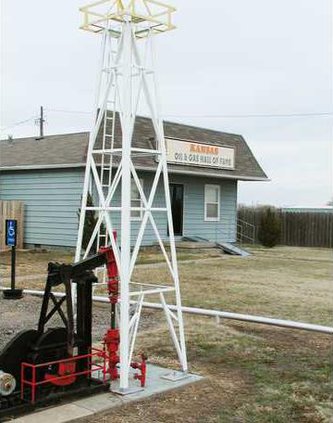You might say Dean Weis was born into oil. While he wasn’t the heir of an oil fortune, he marks his own timeline parallel to when oil really became a fiscal force in Kansas to the present day. The curator at the Kansas Oil and Gas Museum in Great Bend was born in 1929, just as the oil boom hit the Barton County area. By 1930, the county received more than $20 million a year from the oil and gas industry according to some estimates. Weis began working in the industry in his mid-20s, first as an equipment operator, and continued to grow his career until he retired in 1993, never losing his fascination and love of the industry.
For most of us who pay $3.00 or more a gallon at the pump, it may be a shock to learn Weis can remember when gas was $.30 a gallon, a barrel of gas went for roughly $2 a barrel. Compare that to today’s price ranging from $80 to $100 a barrel.
Caught in the snow
Drilling for oil has always been a hard, dirty job that takes operators into the field, in all types of weather. One experience Weis had while working as for Dowell made the pages of an industry magazine which is part of the collection at the museum. It was March, 1957, and Weis was 28 years old, and a new employee with Dowell Oil:
“Two Dowellers at Ulysses, Doug McGillvery and Dean Weis, spent an unpleasant 12 hours or so in the back of a dump sand truck. Also crowded in the truck were six Dowellers from Borger, and three stranded men and three women, 14 all together, most of the week following was spent in “Operation Dig Out.”
Weis was working on a location in Ulysses when he was called back to Pampa, Texas, close to Borger.
“It was so pretty that morning, we’d just left Ulysses to go on this job, and I didn’t even take a coat,” he said. Whether it was generosity, or pity, Weis will never forget how one of the other salesmen who towered over Weis at six-feet-seven-inches, came to his rescue with his a coat. “I was running around in Pampa with that overcoat dragging the sidewalk just about,” he laughed.
“It took us most of a week to get from Pampa back to Ulysses.”
They made it back first to Borger and continued on to Guymon, Okla., where the roads were finally open the rest of the way thanks to the arrival of snowplows with giant augers that threw the snow into tall drifts on either side of the highway.
“When we went through Guymon, you couldn’t see out over the top of the snow,” he said. “They had the highway cleared, but us, sitting up in the truck, couldn’t see out over it.”
More than they asked for
Another unforgettable experience came when he took part in a deep drilling project.
“While I worked for the company, I had the opportunity of working on the deepest well in the world at that time,” he said, producing photos of the rig that drilled it. The well, located down in three miles east of Sayer, Okla.,was 31,400 feet deep.
“We sat out there for a week, trying to pump into it, couldn’t, and one Sunday morning, we were blowing it back and got molten sulfur out of it,” he said. “Obviously they plugged that off real quickly because it would have eaten the pipe and everything up. And they come back up the hole 17,000 feet and we fracked it there and made them a gas well.”
In 1977, Dowell Oil transferred Weis to their Great Bend station and he became the assistant manager. Then came the 1980s, a turbulent time for the oil industry in the U.S.
“In 1983, they sold 50 percent of us to Schlumberger, and 30 days later, they retired 483 of us,” he said. But Weis isn’t complaining. He continues to receive his pension, and he went on to work for his former competitors for an additional 10 years before he officially retired.
Learning the oil business from the ground up, literally and figuratively, has given him both the appreciation and the insight needed to bring understanding to the many school aged children and casual visitors that stop into the museum for a tour each year.
IN OIL FROM DAY ONE
Curator looks back on experiences in oil industry





